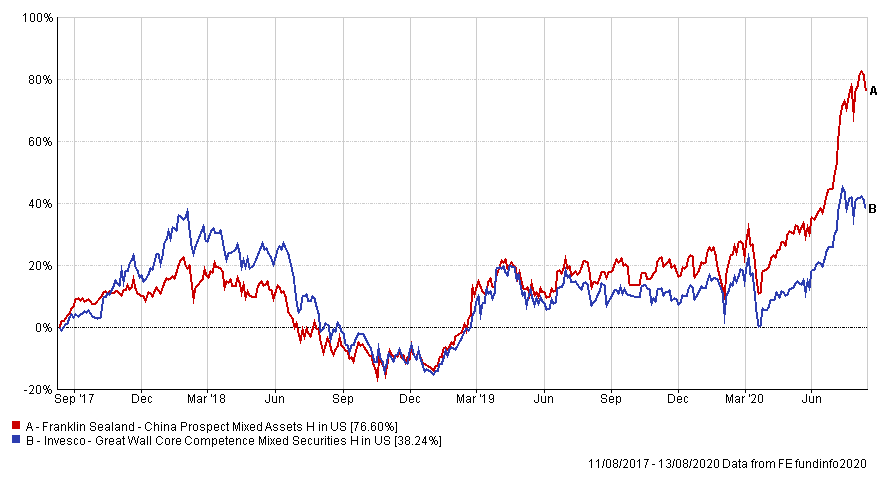The FSA Spy market buzz – 22 November 2024
Dimensional excludes the Middle Kingdom; JP Morgan’s optimistic outlook; Household wealth is rocketing; Schroders is thinking about privates; Ninety One’s pithy AI; German woes and much more.

Li believes that the FTS fund will outperform the IGW product when the market is in favour of higher growth or emerging companies.
“Given its larger position in emerging growth sectors, the FTS fund is expected to perform better,” Li said. For example, this year, the FTS fund has performed nearly 50%, which compares with the mid-20s return of the IGW fund, he added.
On the other hand, Li expects the IGW fund to outperform when the market is driven by the more stable sectors, such as in 2017.
Discreet calendar year performance
| Fund / index / sector | YTD 2020 | 2019 | 2018 | 2017 |
| Franklin Sealand China Prospect Mixed Assets H in US | 48.17 | 36.85 | -21.9 | 25.18 |
| Invesco Great Wall Core Competence Mixed Securities H in US | 23.11 | 30.76 | -30.32 | 56.37 |
In terms of volatility, Li believes that the IGW fund should be less volatile than the FTS fund.
“IGW has a higher allocation in the stable growth sectors than the FTS product, which reduces the volatility of its performance,” he said.
The five-year standard deviation of the FTS fund is 23, which is slightly higher than the IGW fund (22), Li added.
However, when it comes to their three-year annualised volatility, the FTS fund is less volatile than the IGW offering, FE Fundinfo data shows.
Three-year annualized volatility
| Fund / Index | Volatility |
| Franklin Sealand China Prospect Mixed Assets H in US | 22.52 |
| Invesco Great Wall Core Competence Mixed Securities H in US | 25.05 |
 Step up your portfolio by doubling down on sectors set for long-term growth
Step up your portfolio by doubling down on sectors set for long-term growth
 Eastspring landing page
Eastspring landing page
 Tap into Japan’s post-pandemic growth trends
Tap into Japan’s post-pandemic growth trends
 Dynamism is the name of the game for this global macro strategy
Dynamism is the name of the game for this global macro strategy
 Riding the wave of alternative income amongst HNWIs in APAC
Riding the wave of alternative income amongst HNWIs in APAC
 Accessing Asian 5G innovation: three key portfolio themes
Accessing Asian 5G innovation: three key portfolio themes
 Ninety One: Finding opportunities in times of change
Ninety One: Finding opportunities in times of change
 How can a sustainable approach also ensure you don’t compromise performance?
How can a sustainable approach also ensure you don’t compromise performance?
 Healthcare’s innovation shifts into high gear
Healthcare’s innovation shifts into high gear
 Taking a thematic approach to harness disruption
Taking a thematic approach to harness disruption

Dimensional excludes the Middle Kingdom; JP Morgan’s optimistic outlook; Household wealth is rocketing; Schroders is thinking about privates; Ninety One’s pithy AI; German woes and much more.
Part of the Mark Allen Group.
